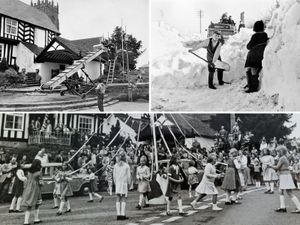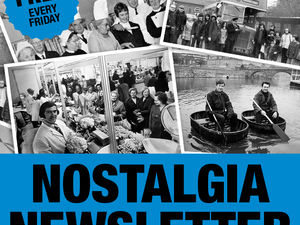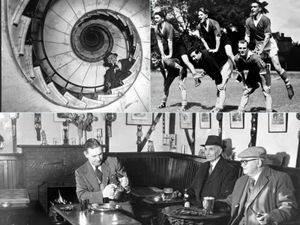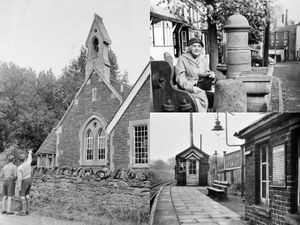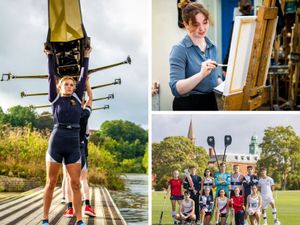The tragic Niagara Falls death of the first person to swim the English Channel
Swimming the English Channel? It hardly creates a ripple these days.
So it's difficult to conceive how big a deal it was when Captain Matthew Webb became the first person to achieve the feat.
He became an instant international hero, although he had already come to national prominence through a dramatic attempted rescue on the high seas two years beforehand.
Some measure of how great an achievement it was can be judged from the fact that it was to be another 36 years before the second person was to swim the English Channel.
That's because, although almost 1,900 swimmers have made a crossing since Webb, it is gruelling and tough.
And, in best Victorian heroic mould, Webb was to die in glorious and spectacular fashion, in a bid to swim the rapids below Niagara Falls.
There is a myth that his body was never found. It was, a few days later, and he is buried at Oakwood Cemetery, Niagara Falls.
In the long term Webb, Dawley's most famous son, saved untold numbers of lives indirectly, because his exploits did much to increase the popularity of swimming in Victorian Britain, although in the immediate aftermath of his Channel swim the number of deaths actually increased as a result of men nowhere near as fit and able as him attempting swimming feats for which they were unsuited.
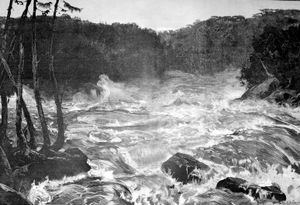
Before his Channel swim, swimming had been largely an outdoor pursuit, enjoyed in open water such as lakes and the sea.
Attendances at public baths shot up and the enthusiasm inspired by Webb can be seen as the foundation of swimming as an accepted modern sport and recreation.
His pioneering Channel swim of August 1875 is all the more impressive in that he was operating with some handicaps which came with those times.
There were none of the modern training regimes which are part and parcel of achieving sporting excellence nowadays, so he had to be both naturally very fit and have an iron will.
And he swam it all breaststroke, and also occasionally on his side, because front crawl was not yet in existence. This meant his crossing was, by modern standards, very slow, and therefore he had to battle the cold and conditions for much longer than today's Channel swimmers.
Today all prospective Channel swimmers must complete a qualifying swim, which is a six hour swim in temperatures of 16C or less.
In fact the American showman and adventurer Captain Paul Boyton swam the Channel three months before Webb, but it didn't really count as he did so wearing a special inflatable suit.
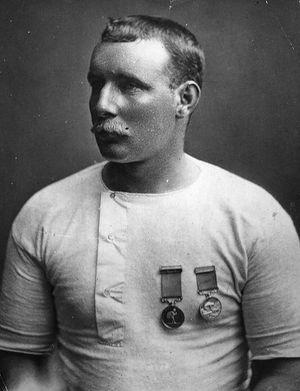
Webb trained for his epic unaided attempt in the River Thames. He swam the 20 miles from Blackwall Pier to Gravesend Town Pier in 4 hours 20 minutes, a record which stood for 20 years.
After diving off Admiralty Pier at Dover his crossing time to Calais was 21 hours 45 minutes, which included five hours in which he made no progress at all because of the strong currents. In the end, fortified by beer, beef tea, brandy and coffee, he swam 39 miles, compared with the point-to-point distance of 22 miles.
Matthew Webb was born in Dawley on January 19, 1848, and consequently is claimed by the Shropshire town as its most famous son. He was one of 12 children – eight boys and four girls – and his father was a local doctor.
He was only in Dawley for the first 14 months of his life, after which the Webb family moved to Madeley, living in the High Street, and then to Eastfield House, Coalbrookdale, where he spent his childhood years and, it is said, learned to swim in the River Severn at the age of seven.
The exact site of his birth in Dawley was long surrounded in mystery, partly because the family moved so soon afterwards, and also because the property was demolished.
However a few years ago local historian Malcolm Peel made it his mission to pinpoint the location.
A big clue was Captain Webb's memorial in the High Street, which was unveiled on October 23, 1909, and the inscription which included the words: “He was born in a house which formerly occupied a site a few yards from this memorial.”
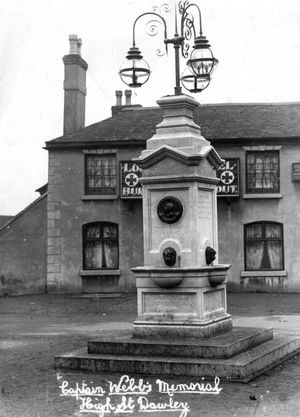
Another significant clue was a remark by the chairman at a public meeting at which plans for the memorial were discussed in June 1909.
Dr Frederick Howard Davis commented that it was a coincidence that he happened to be born in the same house as the late Captain Webb, "a building since demolished, and the site now occupied by some of the four shops adjoining each other located at the bottom of High Street."
Instead of researching the Webbs, Malcolm looked into the family history of the Davis family, together with properties marked on a 1849 tithe map and census records, through which he was able to put the pieces of the puzzle together.
He identified the likely house, which was in an area which was later cleared and four shops, 57, 59, 61, and 63 High Street, were built on the site, which in turn were cleared leaving Webb's birthplace an open service area behind current High Street shops, with nothing to indicate its historic connections.
Tales abounded of young Matthew's bravery and resourcefulness when saving his brother Thomas – or was it Henry? – from drowning in the River Severn, and daringly balancing along the parapet of Buildwas bridge.
Aged 12 he joined the Merchant Navy and served an apprenticeship with Rathbone Brothers of Liverpool.
He was second mate on the Cunard Line ship Russia on a crossing from New York to Liverpool when a man fell overboard into the Atlantic Ocean. He dived into the ocean to rescue the man but was unable to find him. However, he was given £100, which was a very considerable sum in those days, for his courage and presented with the Royal Humane Society’s Stanhope Medal, the first person to receive the award.
Ultimately he became captain of the steamship Emerald, but he left the Merchant Navy in 1874 to become a professional endurance swimmer.
Among his feats were swimming from Dover to Ramsgate, a distance of 18 miles, in eight and a half hours. The crowning glory though would be that pioneering swim across the English Channel, but his first attempt failed due to bad weather.
His second attempt was only a few days later, on August 24, 1875, and to try to keep the cold at bay he smeared himself from top to toe with porpoise oil.
The swim ended in triumph for the 27-year-old.
He was accompanied by the Dover lugger "Ann" piloted by George Toms and crewed by Dodd, Bowles, Jell, Gates, Decent and Stanley. Also on board were Webb’s cousin G H Ward, Charles Baker the diver and pacemaker, and local journalists Bavington Jones, Warman, Payne and Wilkinson (also representing nationals) plus Bell, an artist for the Illustrated London News.
When the exhausted Webb was put to bed in a hotel in Calais, the proprietor organised a trumpet fanfare for the hero.
Webb, however, irate at being woken from his sleep, told the musicians in no uncertain terms to go elsewhere.
He was greeted with public adulation back in England, especially Shropshire, bringing out big crowds in Wellington, Ironbridge, Madeley, and Dawley when he returned home shortly after his swim.
On his arrival at his Dawley birthplace he was rapturously received and an enduring legend was born, that of the Dawley Pig On The Wall, it being said that even a pig stood on a wall to watch the procession go by.
The pig on the wall story, which seems to be traditional folklore which some believe originated in the Black Country, led to the creation of a well-known postcard produced by the Dawley photographic firm of Baldwin Bros at the time of the unveiling of the 1909 memorial.
It was a montage featuring Ernest Fletcher, licensee of the Unicorn pub in Little Dawley, whose pig used to jump on the wall when it heard his voice.

In reality Dawley had only learned its famous son was visiting his birthplace on the morning of the arrival, and welcoming arrangements were quickly made, with triumphal arches and garlands spanning the streets.
A contemporary press report makes no mention of a procession beyond Webb's own cavalcade – he was travelling in a waggonette, accompanied by a large number of his friends from Ironbridge on horseback or in vehicles.
Now a national hero, he made a living through his swimming fame, taking part in competitions and exhibitions, and generally finding ways to spend as much time as he could in his beloved water, including wallowing for 60 hours in a steel tank in Westminster.
On April 27, 1880, Matthew married Madeleine Kate Chaddock at St Andrew's Church in West Kensington. They were to have two children, Matthew, and Helen.
Like many a celebrity whose fame depends on stunts and exploits, Webb sought new ways to find glory, and toyed with the idea of swimming the Irish Channel before settling on swimming the rapids below Niagara Falls, something so dangerous that many considered it tantamount to suicide.
In 1883 he took his wife and children to America.
He entered the water on July 24, and is thought to have survived the first part of the swim, but Webb had at last met his match as he was tossed and battered by the sheer force of the water, and sucked in by the dreaded whirlpool.
His body was found downstream a few days later. He was given a temporary burial and then the following year his widow returned and had a granite column erected over a new burial site.
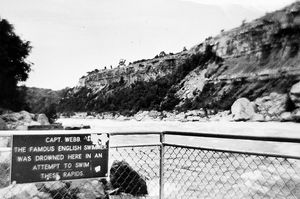
She was later to marry a widower, a Mr England, and move to South Africa.
Both children had notable lives. Matthew junior was to find minor fame in his own right by becoming a pioneer mountain climber in South Africa, while Helen was a pioneer of ballet dancing in that country.
Matthew junior served in the Great War, being wounded on the Somme in July 1916 and killed on March 22, 1918, during the great German spring offensive, while a Second Lieutenant in the South African Infantry. Sadly his body was never recovered.
Matthew senior remains a quintessential Boy's Own-style hero, and his image appeared on England's Glory matchboxes, and there have been various busts of him. He may even have made the movie world, as Peter Sellers is said to have based his Inspector Clouseau image on a picture of Captain Webb.
It took a surprisingly long time for Dawley to honour its famous son, and it was renewed attempts to swim the Channel in the first decade of the 20th century which got locals to start acting on the idea.
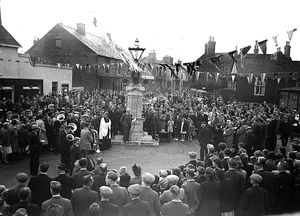
The memorial at the bottom of the High Street unveiled in 1909 originally served as a drinking fountain, with lamps. At the time of its unveiling Webb remained the only person to date to have swum the Channel.
For various reasons over the decades the memorial moved to several different locations, but in recent years has returned to more or less its original spot.
It bears the inscription "Nothing Great Is Easy," which is a quote from Plato's Republic, although has naturally come to be associated with Webb, although it is not clear whether he actually ever said it or it was simply thought an appropriate sentiment for his memorial.
Ironically Dawley, birthplace of such a famous swimmer, has never had a public swimming baths, but plans are in hand which should see the town get a pool to celebrate the 150th anniversary of Webb's Channel swim in 2025.
Matthew Webb factfile
Born: January 19, 1848, in Dawley, although the family moved to Madeley when he was still a tot.
Career: Went into the Merchant Navy aged 12, and between 1866 and 1875 served on seven ships. Became the first to receive the award of the Stanhope Medal for his attempts to save a sailor who had fallen overboard.
Channel swim: August 24, 1875, Dover to Calais, 21 hours and 45 minutes. The feat was not repeated until September 1911 when Thomas William Burgess swam across after numerous failed attempts.
Death: Killed while attempting to swim the rapids below the Niagara Falls on the US-Canada border on July 24, 1883. He is buried at Oakwood Cemetery, New York State.
Memorials: In Dawley a drinking fountain was unveiled on October 23, 1909, at the end of the High Street. A memorial comprising a plinth surmounted by a bust was unveiled in Clarence Lawn, Dover, in July the following year. It was damaged by shrapnel during the war and was stored in a local cave before being re-erected in 1951 at the east end of the promenade, but was moved again in 1991 to a position close to its original site.

